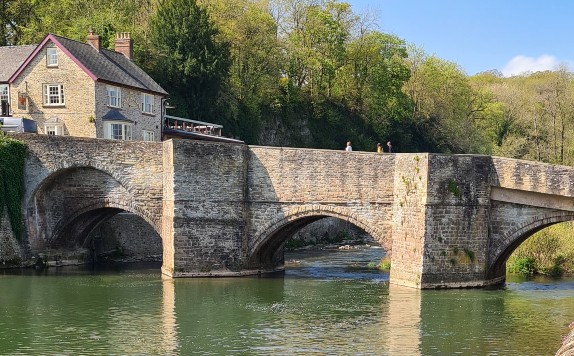Rout at Ludford Bridge
In 1459 tensions turned to conflict. Both the Lancastrians and Yorkists had armed themselves. Retinues were arrayed. The Lancastrians concentrated their forces in the midlands. The Yorkists had agreed to meet at Ludlow. The movement of Yorkist forces under the earl of Salisbury had led to the Battle of Blore Heath. The earl of Salisbury was victorious and continued to Ludlow, where he was joined by his son, the earl of Warwick. The Lancastrian forces followed the Yorkists. With battle inevitable, the Yorkists established a defensive line, equipped with cannon, on the banks of the river Corve at Ludford. What happened next is often called the Rout at Ludford and it led to the Parliament of Devils and a period of Lancastrian dominance.
Defending Ludlow and Ludford Bridge
Ludlow was well defended by the Yorkists. They had cannon at the head of their forces defending the southern bank at Ludford Bridge. Experienced men from the garrison at Calais had been brought to Ludlow by the Earl of Warwick. The Earl of Salisbury’s men, fresh from their victory at Blore Heath, were also present, along with the loyal local forces of the Duke of York.
Ande thys same yere there was a grete afray at Lodlowe by twyne the kynge and the Duke of Yorke, the Erle of Salisbury, the Erle of Warwyke, the Erle of Marche. The Duke of Yorke lete make a grete depe dyche and fortefyde it with gonnys, cartys, and stakys, but hys party was ovyr weke, for the kyng was mo thenn xxx Mlof harneysyd men, by-syde nakyd men that were compellyd for to come with the kynge. And thenne the duke fledde fro place to place in Walys, and breke downe the bryggys aftyr hym that the kyngys mayny schulde not come aftyr hym. And he wente unto Irlonde.
Negotiation at Ludlow
The two sides met each other at Ludford Bridge, outside the town. York’s men took a defensive position on the south bank of the river. Parley was attempted. The King offered a pardon to all except those responsible for Lord Audley’s death: this would not have pardoned the Earl of Salisbury. Throughout the night of 12th/13th October, cannon were fired toward the Royal lines.
The Calais Garrison under Andrew Trollope changes sides
The Parley demonstrated to some of the Yorkist troops that the King himself was present. The Royal Standard was clearly visible. The Calais Garrison was not willing to fight the King himself. During the night, the men from Calais switched sides.
‘…but in the nyght Andrewe Trollop and all the olde souldyours of Calays with a grete felawshyp sodeynly departed… and wente strayte unto the kynges felde where they were receyved joiously… Walsingham, T., Historia Anglicana, vol. ii, ed. by Riley, H.T. (London, 1864),
The Rout at Ludford Bridge
The consequence of the Calais contingent under Andrew Trollope defecting to the royal army was that the Yorkist lords decided that to fight would be disastrous. And so, in the middle of the night, they fled. The flight of the Yorkist lords was recorded and described in the Act of Attainder that was passed at the November 1459 Parliament in Coventry (The Parliament of Devils). Whilst it has a focus on denouncing the duke of York and arels of March, Salisbury and Warwick, along with their prominent adherents, the record is useful in terms of what the Yorkists did. This official record shows that the lords abandoned their standards and positions during the night, fleeing into Wales.
But Almyghty God, that seth the hertes of people, to whome is nothyng hidde, smote the hertes of the seid duc of York and erles sodenly from that most presumptuouse pryde to the most shamefull falle of cowardise that coude be thought, so that aboute mydnyght than next suyng they stale awey oute of the felde, under colour they wold have refresshed theym awhile in the toune of Ludlowe, levyng their standardes and baners in their bataill directly ayenst youre feld, fledde oute of the toune unarmed, with fewe persones into Wales; understondyng that youre people hertes assembled was blynded by theym afore, were the more partie converted by Goddes inspiracion to repent theym and humbly submytte theym to you, and aske youre grace, which so didde the grete part; to whome, at Oure Lordes reverence and Seint Edward, ye ymparted largely youre grace. But, soverayne lord, it is not to be thought, but they and it had been possible to theym by eny meane, their wille was to have accomplisshed their cruell, malicious and traiterous entent, to the fynall destruccion of youre moost roiall persone. Act of Attainder
‘Henry VI: November 1459’, in Parliament Rolls of Medieval England, ed. Chris Given-Wilson, Paul Brand, Seymour Phillips, Mark Ormrod, Geoffrey Martin, Anne Curry and Rosemary Horrox (Woodbridge, 2005), British History Online http://www.british-history.ac.uk/no-series/parliament-rolls-medieval/november-1459
Flight of the Yorkist Lords from Ludford
The flight of the Yorkists saw the lords travel to different locations. The duke of York made his way to Ireland, where he had many men who were loyal to him as a result of his Lieutenancy of Ireland. The earls of March, Salisbury, and Warwick made their way to the south coast from where they travelled to Calais, where the earl of Warwick had been Captain for several years.
Related Content on Richard 3rd Duke of York
Justifications of Yorkist actions in 1459
Richard 3rd Duke of York and the Act of Accord
Richard duke of York slain in the Battle of Wakefield
Wakefield, Mortimer’s Cross and St. Albans
Edward IV declared King of England
Reburial of Richard 3rd Duke of York
Ludford Bridge Image Credit
Ludford Bridge. Photograph kindly sent to us by Gerry Lyons, copyright remains with Gerry.
